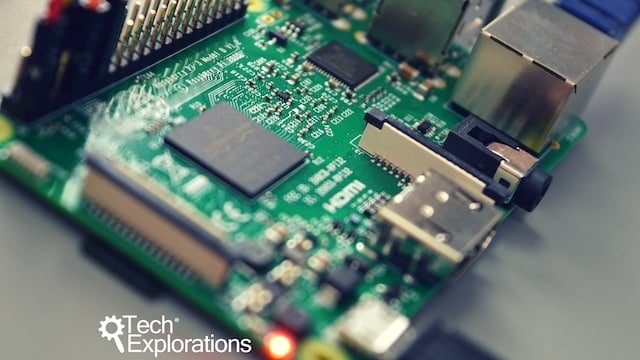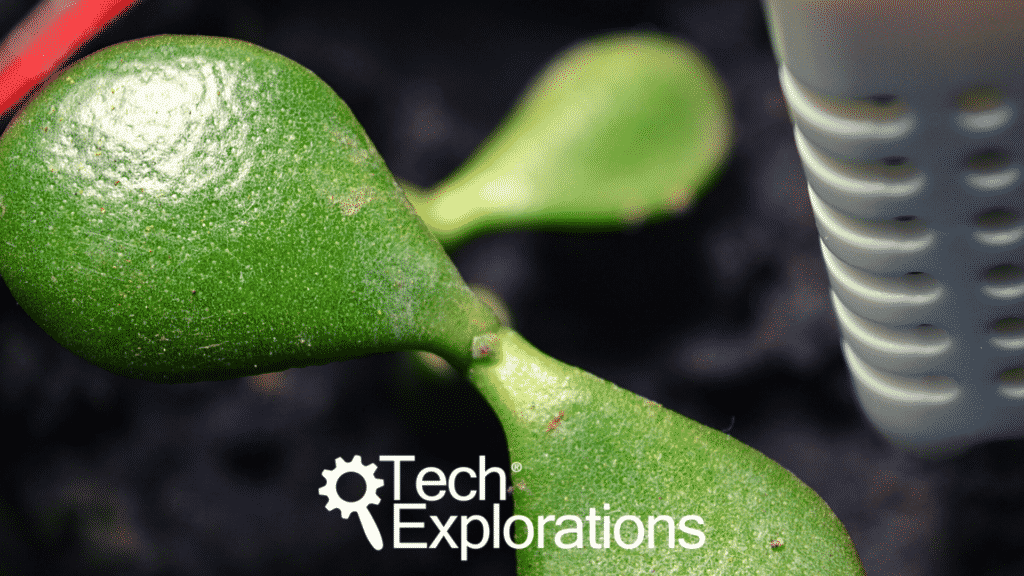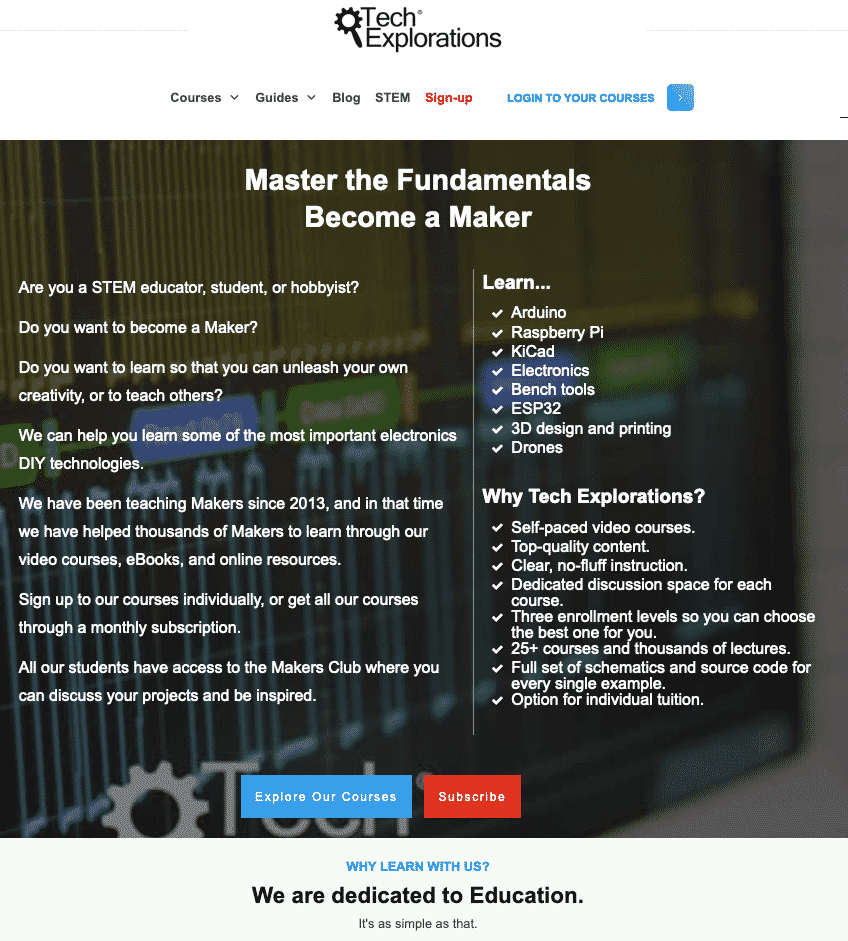Table of contents
What a year this was!
It surely turned out to be one to remember.
The novel coronavirus and the havoc that it created across the world left almost nothing unchanged.
Every industry has been affected, and we are just beginning to understand the magnitude of the changes that are underway.
Tech Explorations is an education company with a wide-ranging audience. We work with STEM students and teachers, but also with people who have a passion for electronics and are committed to life-long learning: Makers.
As I am writing this article, we are closing towards the end of the year-milestone. I decided it was an appropriate time to look back and reflect.
What did we, at Tech Explorations, achieve?
I’ve broken down my review to 5 parts: Content, Website, Community, What’s Next, and, of course, shout-outs!
Content
The most significant impact of the pandemic on Tech Explorations was with the content we had planned to publish versus what we actually published.
The plan was to publish 5 or 6 courses and one book between January 2020 and December 2020.
Here’s what we published:
STEM Education Summit
When the pandemic hit Australia in earnest in March, we had already published an update of Raspberry Pi Full Stack, plus a brand-new eBook and print book version.
As I was talking to teachers from Australia and around the world, I realized that the Education sector was being affected uniquely.
Almost every industry has indeed been affected by the pandemic. Hospitality, transportation, retail …
But I think that education is unique in the sense that this industry affects every child and teacher, and as a result, every parent and family.
In the early stages of the pandemic, the challenge for teachers and the education system was how to adjust within days or weeks (at most) to transform a traditional face-to-face mode of teaching and learning to an online, remote, technology-driven model.
Students are generally able to deal with the technological requirements quickly (as long as they had a computer and Internet connection at home, which was/is not always true even in “advanced” societies). However, they often lacked the discipline required to learn in a solitary and self-driven way.
For parents, the challenge of working at home while helping their children with their online education work, and in many cases replacing a teacher, was also a very stressful and often brutal new reality.
So, instead of carrying on with the plan and producing new courses, we took two months to fast-track a STEM Education online Summit.
With the recent experience of our Makers Mind Meld Summit, we had the technical aspects of the Education Summit covered. Still, the organizational challenge of finding the best possible educators and getting them to commit their participation at a time that was already stressful for them was signification.
In the end, we achieved the participation of 28 outstanding educators who delivered 23 presentations.
It was a real pleasure working with them, and providing a platform where they could codify and communicate the way that the adjusted and thrived in a new educational environment.
We published the Summit a few days ahead of time, and access was free for everyone on the weekend of June 27 and 28.
Courses
In 2020, we published three new courses, updated one, and published a new book.
Raspberry Pi Full Stack
As I mentioned earlier, first to complete was an update to Raspberry Pi Full Stack. With the availability of the Raspberry Pi 4, and the updated operating system (the “Raspberry Pi Operating System”), I decided to refresh the course and bring it up-to-speed with the latest and greatest in the Raspberry Pi ecosystem.
This was more than an update: I took the opportunity to add new content and write a book.
I worked to make the new Raspberry Pi Full Stack compatible with the latest versions of the various JavaScript and Python interpreter and libraries available in February, and of course to ensure that the stack played well with the Raspberry Pi Operating System.
Of course, the operating system is still Raspbian, but when there is a new version released one can never be sure that a small change in one of its components will not break something in the user application stack.
Apart from bumping up the dependency versions, I also added new content, with an emphasis in the Internet of Things (such as data logging in Google Sheet, and alerts via IFTTT) and extending the hardware so that the application can acquire data from Arduino nodes.
The additional content provided an example of how one can use the application as a platform on which they can build your custom features.
Billy Hare did just that and extended his instance of the Full Stack app to work with Twillio and support text messaging. Billy documented his extension, and we published the full code and instructions as s full new section in the book.
Speaking of the book …
What can I say …
Every time I write a book, I say it’s the last one. A lot of work, slow progress (compared to a video course), painful. But, the result is satisfying, and it does look beautiful on the bookshelf.
As with KiCad Like a Pro, Elektor published the print version of Raspberry Pi Full Stack. Both eBook and print versions of the book contain the same content and include the Twillio extension (which is not available in the video course).
Node-RED and ESP32 project
With the STEM Education Summit complete, it was back to the courses. The first one to go out was a project course that combined Node-RED with the ESP32.
As Node-RED is server-side software, I chose the Raspberry Pi 4 as the server.
Why did I decide to work with Node-RED?
I’ve been monitoring this technology for several years. Over that time, it has grown to become a fast and stable platform, with increasing popularity among hobbyists and professionals alike. Professional engineers even use Node-RED in industrial applications, which is a sign of maturity.
So, I decided to create a course about it.
I wanted to make this a project course, rather than a reference course (similar to Arduino Step by Step Getting Started or ESP32 for Busy People). I did this because I found that the learning curve of Node-RED and its components is relatively low, but that using to build a reliable control system is more complicated.
A control system is something you would find in an industrial setting, or, in my case, in my lab. So, I needed something to control within the confines of my lab, and that was a terrarium.
I wrote about the inspiration behind the terrarium controller project in a blog post back in June.
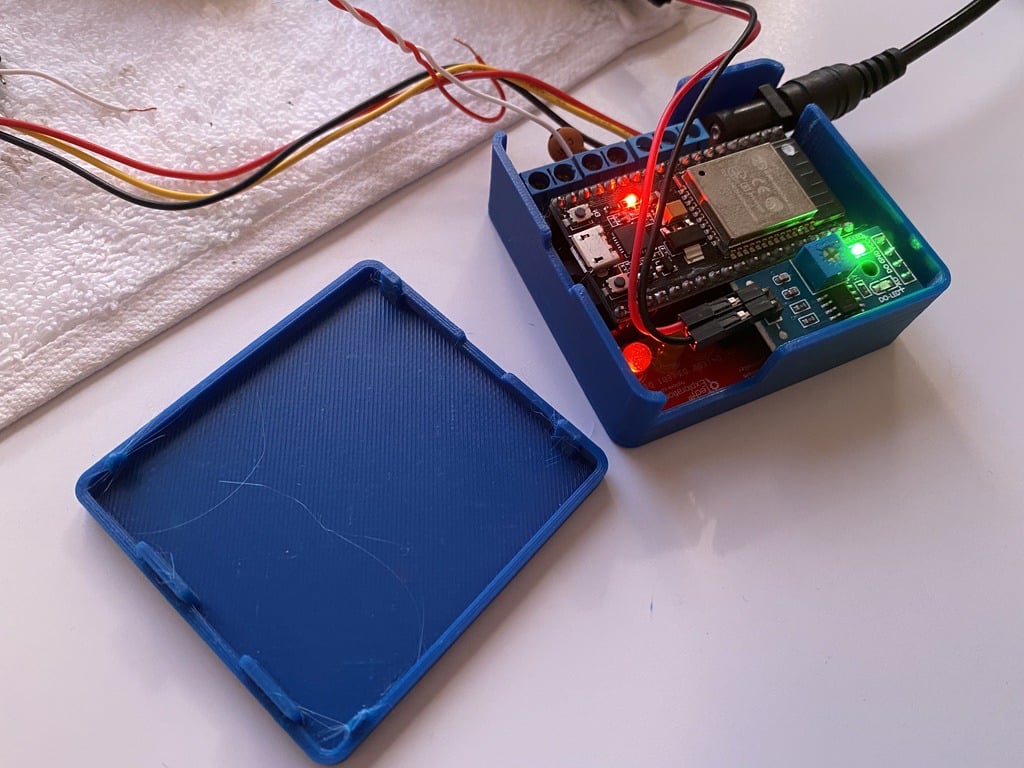
Overall, it was a fun project. Even though I managed to flood my terrarium a couple of times, and eventually kill the plant that was growing in it due to drought (I forgot to add water to the tank), my objective was to build a respectable Node-RED application, which I did. It was complete with a custom PCB and a 3D-printed case.
Arduino for Beginners with Grove
Makers recognize Seeed Studio for its Grove family of components for Arduino and other devices. I published a Grove-related course a couple of years ago.
But in late 2019, Seeed released the Grove Beginner Kit for Arduino. I was impressed by the innovative approach to kit design, and saw a lot of potential, especially for use in the education sector.
Unlike traditional kits, the Grove Beginner Kit comes as a single PCB, with all of its components already connected to the Arduino Uno compatible board that is part of the kit. I wrote a blog post with my first impressions after trying it out for the first time.
Considering that educators use many of our courses and that we run an Arduino Bootcamp specifically for people new to the Arduino, I decided that a course on the Grove Beginner Kit for Arduino would benefit many people in our Community.
And so, we published this course in August.
A few months later, in November, Seeed released a new board with the same innovative design, the Grove Sensor Kit. The new kit contains the same set of sensors and actuators as the Grove Beginner Kit, but instead of an Arduino Uno compatible board, it has an Arduino Uno shield. With the shield, you can use any Arduino with a compatible header.
I thought this was “cool” since I was now able to use boards such as the Arduino Mega 2560, the Arduino Due, or even my old Arduino 101.
In early December we published an extension to the “Arduino for Beginners with Grove” course to cover some of the use cases of the Grove Sensor Kit.
Arduino Mobile Development with Blynk
Blynk is another technology I have been very interested about. Plus, people in the community expressed the same interest.
What best way to learn a new technology than through a project?
Blynk is a platform for building and running smartphone apps that interface with microcontrollers or computers.
With a few taps, you can create an app that allows you to control digital pins on your Arduino, or read sensor values.
While it is trivial to do such thing on the microcontroller itself, integrating with a mobile phone has always been a challenge. Writing smartphone apps is not trivial. Then, figuring out how to transport data across WiFi or 3G/4G/5G networks, and doing it safely increases the difficulty level significantly.
And because it is 2020 (soon to be 2021) and not 1995, the elegance of the user interface matters.
The Blynk platform engineers have brilliantly dealt with such issues. Since its early days after a successful Kickstarter campaign, Blynk is now a stable and rich platform on which companies can build their Internet of Things applications, and hobbyists can experiment with their home-automation ideas.
In this new course, what I wanted to explore in detail was the Blynk server. The server is a free Java application that can run on any computer that has a Java runtime environment. I used a Raspberry Pi Zero W, of course. I connected my Arduino and ESP32 to the Raspberry Pi via WiFi, and build a simple application that allows me to view (and record) sensor data on my phone. With a simple configuration of my router, I was able to access my home-based Blynk server from anywhere on the Internet.
This project was fun, but, most important, it was a testament to how far this technology has progressed. I often have discussions about the importance of Makers being able to control and understand the entire technology stack on which our creations depend.
However, I realize that our technology has evolved to a degree where everything useful is built upon multiple layers of specialized functionalities. Anything that relates to communications, computation, storage, and machine learning is the culmination of hundreds of hours of painstaking work by brilliant engineers.
Is there any hope for any of us understanding the intricate details of each one?
I am more convinced than ever that our best strategy as Makers and creative people is to gain an understanding of system design and integration. If we are really keen, we may even attempt to gain a deep understanding of the intricacies of a single layer technology.
Perhaps systems thinking for Makers should be my next course?
Guides
This year was big also because of the effort we put into the publication of free guides on our website.
Free guides have always been part of our publishing philosophy, but it has mostly been an afterthought.
In 2020, publishing free guides became part of the publishing process of a course.
Alongside our new courses for 2020, we published multi-part series to help people get started with a new technology without barriers.
Today, on the Tech Explorations website, you can find seven free guide series for the Arduino, two for the ESP32, and single series for KiCad, Node-RED, Raspberry Pi, the oscilloscope, Blynk, and Altair Embed.
Each of those guides can easily take several weeks of full-time work, so our investment in this process is significant. But we can see that they have a positive impact on the Community, so we will continue to add new guides.
Our latest set of guides were for the Arduino. Within November and December of 2020, we published these Arduino Guides:
More to come in 2021.
Website
2020 was a year of transformation and consolidation for our website.
Since 2014, when Tech Explorations published Arduino Step by Step Your Complete Guide on Udemy, the website has taken up a lot of my time. I was never happy with the way it looked and performed.
I am not much of a designer, so anything relating to aesthetics was particularly problematic for me. It took me years to figure out how to setup a modern website. I am still learning.
However, I can say with a dose of satisfaction that the current website looks decent and works well.
I hope you agree.
Aside from the aesthetics, a significant sink for my time went to the back end. The back end is where our courses “live” and where our students spent most of their time.
For our website to be useful, it has to be fast and stable.
If it breaks, students will lose trust and leave.
If it is slow, people will give up and leave.
I have spent thousands of hours learning how to set up and administer a website so that it is both fast and stable. I spent thousands of hours learning how to integrate it with external components (such as the Paddle payments system, the Drip email system, and the Zapier integration system) to create a reliable and scalable platform for Tech Explorations.
2020 was the year where all this work finally came together. After six long years, I can now confidently say that our online infrastructure is top-tier. Notwithstanding me doing something stupid, or Google, Amazon or Cloudflare falling over, our website now works great.
Our uptime for the last month was 99.991% for the front end and the blog, and 99.994% for our courseware (back end).
Here are a few highlights of our 2020 milestones for the website:
- Website split into two parts: front and back. Each side has dedicated resources, operates independently, and with improved security.
- Moved to a new host to make it easier to adjust resources and manage.
- Moved payments to Paddle. Paddle now handles all payments, taxes etc. These were considerations that were driving me crazy. We don’t hold any financial data.
- After outsourcing payments to Paddle, we were to implement a two-tier enrollment structure (solo and community).
- We have just implemented a subscription option whereby one can purchase a monthly subscription and access all of our video courses instantly.
- Moved our Help Desk to Jira. We used to self-host the help desk, which caused way too many problems.
- Moved our Community to Circle. As with the Help Desk, we used to self-host the course forums. This complicated our infrastructure and caused too many problems.
- Tightened integration of all parts using Zapier as the glue.
My plan for the website is to emphasize stability and improve speed. I don’t plan to introduce new features (hurray!).
(note to myself: test, test, test before release).
Community
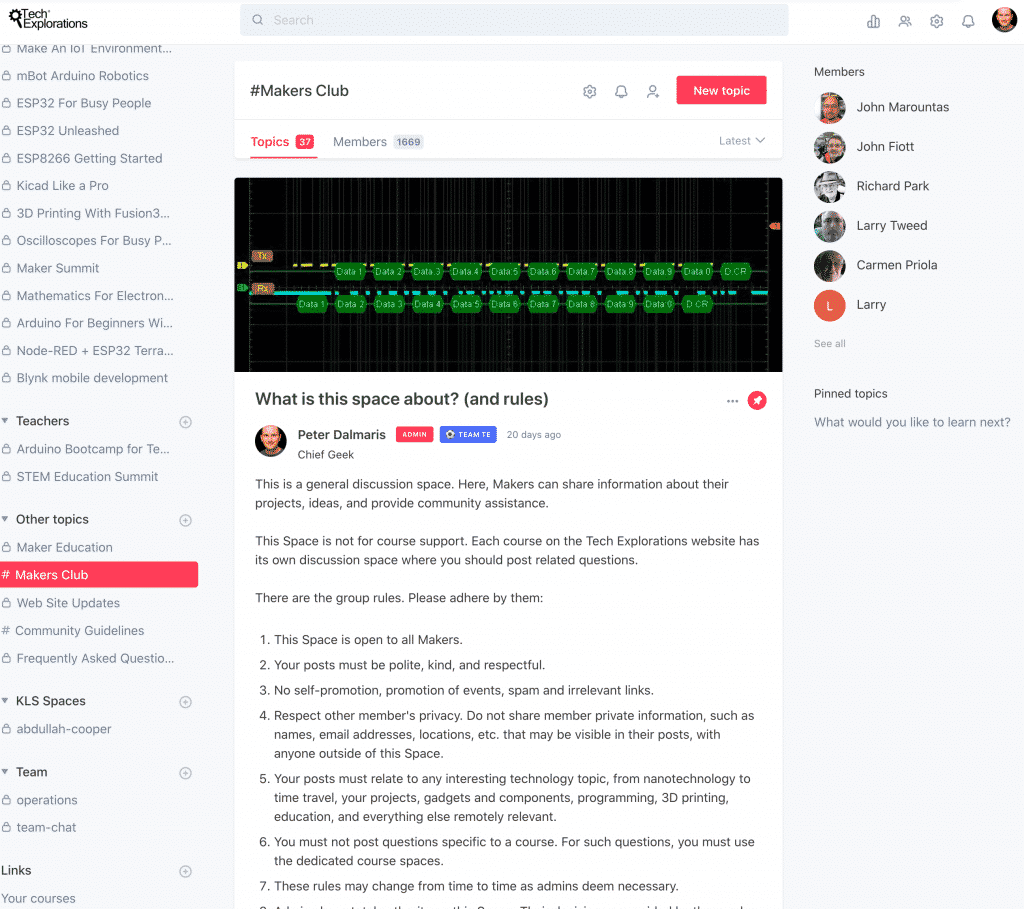
I always envisioned Tech Explorations as a Community. However, implementing the idea into a functioning and self-sustaining community is easier said than done.
In previous iterations of our website, the community was simply a collection of forums, one per course. There was also the Makers Club, hosted on Facebook. There was no conference between the individual parts, and never “felt” like a community.
What is a Community? my simple definition is that a community is a group of people that share certain common characteristics and interests. These commonalities bring people together. Over time, familiarity and care emerge, and community members begin to interact and help each other.
I don’t feel that we have achieved a community in that sense, yet. It is a work in progress.
However, I think that we are on track.
Around March of 2020, we ditched the original course forums and Facebook in favour of our stand-alone community, powered by Circle. Rudy, a web site designer who helped us with our website in the early days, is one of the co-founders of Circle and gave us early access. Thanks’ to this early access, we were able to integrate Tech Explorations with Circle very early. The integration process involved writing several scripts in Ruby, which was a blast from the past for me. Prior to starting Tech Explorations I did a lot of Ruby on Rails programming.
Technically, I am thrilled with this integration. Each lecture is linked to a community topic to facilitate focused discussions in a seamless manner.
By far, the busiest part of the Community is the Makers Club. Moving away from Facebook was one of my most important decisions. Why? Two of my most important criteria for Community health are (1) respect for privacy and (2) noise. Facebook lacked both: no privacy for our members, and too much noise. The noise (i.e. advertisements, random people messaging me, crazy activity in my timeline etc.) made me feel real stress every time I logged in to Facebook to see what is happening with the Makers Club.
The Maker’s Club and the Community are now more active than ever before. Here are some numbers:
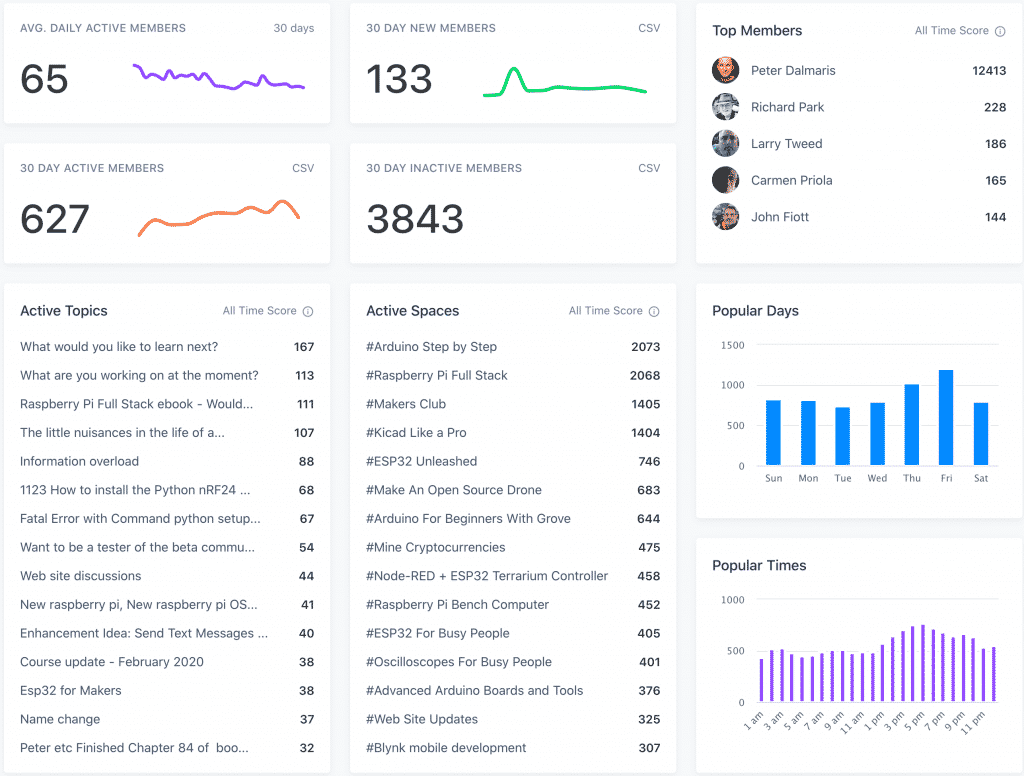
- 1663 active members
- 68 active daily members
- Top topic: What would you like to learn next?
- Most active space: Makers Club, followed by Arduino Step by Step.
- Most active commenter (other than myself): Richard Park.
- Top topic starter (other than myself): Carmen Priola.
- Most likes received (other than myself): John Fiott.
- Most popular topic: ESP32 for Makers in the Makers Club.
- Most engaged Spaces: Makers Club, followed by Raspberry Pi Full Stack
The future of education is online, but education has been and will always be social. That is why I believe that the Community is the centrepiece of any educational institution. We will continue our effort to improve the Tech Explorations Community for the benefit of all its members.
What’s happening in 2021?
2020 has been a year to remember. I believe that it is also a year that should make us think very hard about our role in modern society, and especially our individual responsibilities.
Covid-19 has taken a terrible toll on people and societies. While the virus and the disease itself are out of our control, the way that we respond is well within our control.
I observe that in places with strong leadership and social-individual cooperation, the human toll has been far smaller than in places where leadership and cooperation were lacking.
The former are also much better positioned for recovery.
Of course, we don’t need a pandemic to remind us that leadership and cooperation are complementary and necessary conditions for success.
Or do we?
In a democracy, cooperation is only possible when there is a trust of leadership and the institutions of power. Leadership must earn this trust should by demonstrating competency and merit.
Leadership itself must be cooperative.
Leadership must listen to society and its scientific experts; it must be grounded in objective reality.
Only then will leadership be in a position to make decisions that have the best chance of improving the lives of the people. Only then will people be able to trust those decisions and implement them cooperatively.
From these observations, I focus on the value of “collaboration“.
In 2021, my priority is to collaborate as much as possible on every level.
I want to collaborate for the creation and publication of new courses, new courses, new guides.
I want to help people that are experts in a relevant field to create high-quality content and offer it to the world.
What are these relevant fields? Here are some examples:
- DIY technologies or platforms, like microcontrollers or computers, Internet of Things, programming languages, machine learning, tools, services like Amazon AWS, Microsoft Azure, Google Cloud,
- Educational resources, like class-ware, methodologies, lab resources and experiments with hardware and software,
- How-to guides for Makers and Educators. Example: how to solder, how to repair, and to use a solenoid, how to use a transistor, etc.
- Projects in electronics and programming. A project that involves more than two hardware components and involve non-trivial programming is particularly interesting.
So, here’s my call for collaborators:
- If you believe that you are an expert any of the items in the list above, AND
- you want to share your knowledge with others, AND
- you are willing to co-produce a high-quality publication, AND
- you are reliable (i.e. you do what you say you will do, and finish what you start),
…then contact me, and let’s talk about your idea.
Let’s collaborate!
Shout-outs
I want to take a moment to acknowledged and the efforts and contributions of the Tech Explorations team members, and of many of our students and collaborators.
Specifically:
- Michelle, for doing all the back office work necessary for a business to stay in business.
- Lina, for taking my raw videos and converting them into finished courses, for taking care of the Help Desk, and assistance with much of what we publish on the website and various social media.
- John and Vagelis for looking after our students on our Community and Udemy.
I want to acknowledge the amazing educators that made it possible to publish the STEM Education Summit in record time, during a particularly difficult time:
- Seven Vinton
- Michael Scott
- Meridith Ebbs
- Dr Jorge de Sousa Pires
- Celinda Corsini
- Joseph Murdoch
- Karsten Schulz
- Matt Richards
- Kurt Yang
- Richard Park
- Dr Peter Ellerton
- Kieran Nolan
- Jesse King
- Prof John Fischetti
- Nicola O’Brien
- Gil Poznanski
- Professor Ken Dovey
- Marianne Malmstrom
- Jim Taylor
- Brian McNally
- Julie King
- Martin Richards
- Silke Bethke
- Catherine Squire Blatti
- John Nyagah
- Stephen Hohm
And of course, a huge “thanks!” to some of our most active students:
- Richard Park
- Larry Tweed
- Carmen Priola
- John Fiott
- Rich Mag
- Dan Davis
- Steph
- Mike
- Carl Smith
- Billy Hare
- Steve Tripoli
- Pablo da Rocha Freitas Silva
You Rock!
And that’s 2020!
A year that will live in our memories in infamy due to the pandemic and all the misery it has brought to the world.
For me, personally, a very productive and satisfying year on which I will do my best to build on in 2021.
The Community topic for this post is here.


